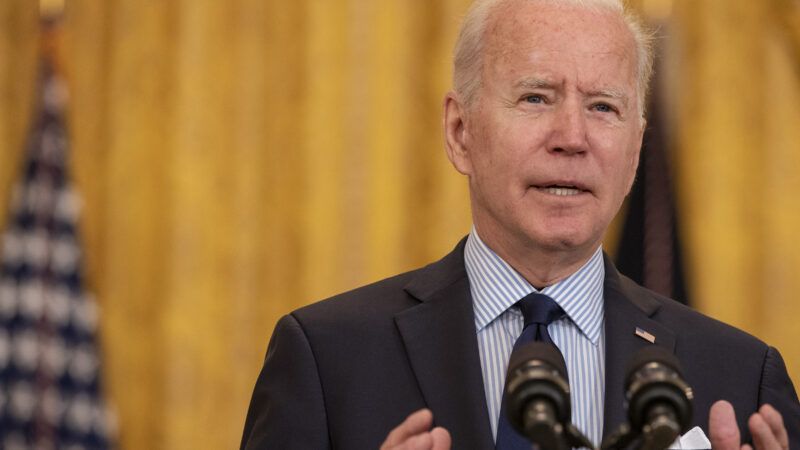New Jobs Report Shows the Government Gets the Unemployment It's Paying For
High unemployment benefits are getting the blame for disappointing job growth in the midst of a worker shortage

A disappointing new jobs report shows that hiring is down and the unemployment is rate is up, even as wages climb and employers complain about a shortage of workers. That apparent paradox has some policy wonks pinning the blame on expanded jobless benefits that pay workers more than what they could expect to earn working.
The economy added 266,000 jobs in April according to today's report from the Bureau of Labor Statistics (BLS), while the unemployment rate ticked up slightly to 6.1 percent, from 6 percent.
These numbers are well below forecasts from economists who predicted that April would see the addition of around 1 million jobs, and the unemployment rate falling to 5.8 percent. The BLS report notes that we're still far away from a pre-pandemic labor market, when the jobless rate sat at 3.5 percent.
Despite persistent levels of high joblessness, other metrics show signs of a labor market that's increasingly tight.
"Even though the pace of hiring was disappointing in April, the labor market has still been behaving as if there was relatively little or even no slack left," wrote economists Jason Furman and Wilson Powell III in a blog post for the Peterson Institute for International Economics, noting that job openings and the number of workers quitting their jobs were at record highs and that wages were growing at 2019 levels (when the country's economy was booming).
Employers, meanwhile, find themselves in increasingly dire straits trying to find new workers. "Hiring remained a widespread challenge, particularly for low-wage or hourly workers, restraining job growth in some cases," reads a Federal Reserve report from April, citing a particularly acute shortage of drivers, housekeepers, and skilled tradespeople.
A Wall Street Journal article from yesterday notes that major employers like Amazon, Walmart, and Target are all raising wages to attract workers, while others are offering gift cards and other perks to entice new hires.
So, what's causing this weird mismatch between labor supply and demand?
Furman and Powell cite three possible explanations: continual health concerns about contracting COVID-19 at work encouraging some people to stay home, school closures keeping parents out of the workforce, and generous unemployment benefits.
The $300 weekly unemployment supplement provided as part of the March-passed American Rescue Plan pays some 42 percent of workers more than what they made at their old jobs, according to a University of Chicago analysis.
That $300 supplement will continue until September 2021. Today's jobs report has business interests calling for ending it now.
"The disappointing jobs report makes it clear that paying people not to work is dampening what should be a stronger jobs market," said Neil Bradley, executive vice president and chief policy officer of the U.S. Chamber of Commerce. "One step policymakers should take now is ending the $300 weekly supplemental unemployment benefit. Based on the Chamber's analysis, the $300 benefit results in approximately one in four recipients taking home more in unemployment than they earned working."
The consensus among economists is that high unemployment benefits were not producing high unemployment rates earlier in the pandemic, when there were so few jobs available, health concerns were more acute, and there was greater uncertainty about when the economy would improve.
Workers who found themselves in that precarious situation would jump at any employment opportunity they could find, even if it paid less than unemployment benefits, the thinking went.
The situation today is much different.
Vaccinations and falling cases and deaths should ameliorate many of the health concerns people have about returning to work. A wealth of job opportunities also means people receiving unemployment benefits now won't automatically take whatever work they can find. Instead, they can afford to hold out for higher wages or a job that's a better fit for them.
The aforementioned Wall Street Journal article quotes Lorne Zaman, who was working in the entertainment industry prior to the pandemic and is deciding to wait for more jobs in his old profession to open back up before reentering the labor market.
"I really enjoyed what I did," Zaman said. "If the government is going to pay you to stay home, you're going to do that unless that job you really want comes along."
A quicker pace of reopenings would likely get workers like Zaman off the sidelines. More industries operating with fewer restrictions would create not just more job openings, but a greater variety of jobs. So would cutting current levels of unemployment benefits.
President Joe Biden, at a press conference today, disputed the idea that generous unemployment benefits were behind today's anemic jobs report, citing the number of jobs the economy did post, while also urging patience about the recovery.
"We knew this wouldn't be a sprint. It would be a marathon. Quite frankly, we're moving a lot more rapidly than I thought we would," he said, according to The Washington Post.
Expectations: managed.
Rent Free is a weekly newsletter from Christian Britschgi on urbanism and the fight for less regulation, more housing, more property rights, and more freedom in America's cities.
Show Comments (300)